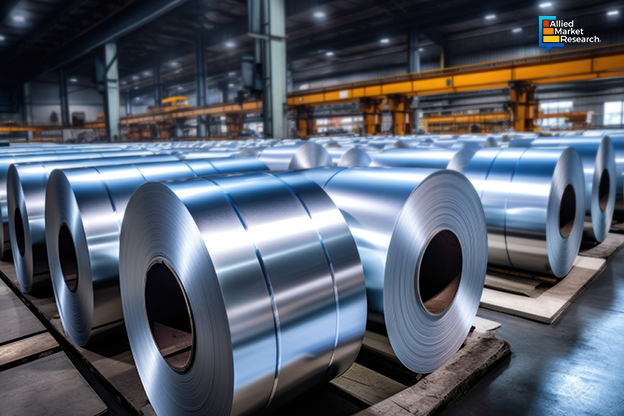Hot-Dip Galvanized Steel Industry: Highlighting the Impact of Novel Technologies on Fabrication Businesses

30 Jul
2024
Highlights:
- Introduction
- Recent developments in the hot-dip galvanized steel industry
- The competitive scenario of the landscape
Hot-dip galvanization is an industrial process that involves coating iron, steel, or other ferrous materials by immersing them in a bath of molten zinc. The main purpose of applying a zinc layer is to protect the underlying steel or iron from corrosion. Manufacturing and construction industries generally prefer hot-dip galvanized steel as its longevity is much greater than regular steel. Furthermore, galvanized steel can be easily recycled, repurposed, and reused without any quality loss. Owing to these advantages, many experts have tried to develop new techniques that can further improve the quality of the hot-dip galvanization process and increase the strength of fabricated steel.
Innovations focusing on improvising hot-dip galvanization processes
Conventionally, the process of hot-dip galvanization takes place at around 400 degrees Celsius. However, it has been found that the same process when done at higher temperatures enhances the quality of coating drastically. This breakthrough technique of galvanizing steel at 600-650 degrees Celsius improves the bonding between the zinc layer and the underlying steel or iron. The corrosion resistance of the ferrous metal, thus, improves, enhancing its durability and extending its lifespan. Along with this, thin-film galvanizing has also become quite popular in recent times. As the name suggests, this technique refers to the application of a thin film of zinc over the steel substrate for a more precise and uniform layer.
Another important development in the hot-dip galvanized steel industry is the advent of alloy galvanizing technology. In this process, zinc is combined with other metals such as magnesium, nickel, aluminum, etc., to form a homogenous alloy. The alloy is then applied to the metal substrate to improve the corrosion resistance. Since the past few years, alloy galvanizing has been widely used in different end-use industries including, automotive manufacturing and construction. Additionally, steel fabrication businesses are also using polymers in combination with zinc to provide a dual-layered protective film to the steel surface. This dual protection not only protects the steel structure from corrosion, but also offers resistance to UV radiation, pollution, and harmful chemicals.
The use of automation technologies to better the quality of hot-dip galvanized steel is one of the recent trends witnessed in the industry. Several galvanizing companies are implementing different technologies to improve the overall efficiency of processes such as degreasing, rinsing, pickling, pre-fluxing, etc. For this, advanced sensors, monitoring systems, and programmable logic controllers are deployed which keep a check on various process parameters including, quality of the layer and film thickness.
Nippon Steel announces the launch of novel hot-dip galvanized steel sheets
Since galvanized steel is used in a wide variety of end-use industries, the hot-dip galvanized steel industry has been expanding globally. Favorable government policies and the growth of the construction industries in developing countries such as India, China, Japan, and South Korea are expected to help the landscape flourish in the Asia-Pacific region. Furthermore, the increasing demand for galvanized steel from different manufacturing companies is predicted to strengthen the industry’s position in the province.
Apart from this, many iron and steel fabrication businesses are launching products to establish their foothold in the industry. For example, in 2021, Nippon Steel, Japan’s largest steel manufacturer, unveiled ZAM®-EX, a series of corrosion-resistant hot-dip galvanized steel sheets. Nippon Steel, in its press release, has stated that the product has been launched to address the demands of its clients in the field of solar power generation.
Along with Asia-Pacific, the industry has flourished immensely in regions such as Europe and North America. ThyssenKrupp Steel, a leading supplier of high-grade steel, in October 2022, announced that it had set up a new hot-dip galvanizing line in Dortmund, Germany. With a capacity to manufacture 600,000 metric tons of flat steel, the new facility in Dortmund is projected to become one of the leading production centers for high-quality hot-dip galvanized steel goods.
To summarize, the hot-dip galvanized steel industry has witnessed the development of innovative techniques and advancements in the recent past. These technologies are anticipated to bring in new opportunities for growth in the landscape. Moreover, favorable government policies and the establishment of new production lines by steel companies are predicted to increase the revenue share of the sector.
To understand the investment opportunities in the hot-dip galvanized steel industry, feel free to contact us.

Koyel Ghosh
Author’s Bio- Koyel Ghosh is a blogger with a strong passion and enjoys writing in miscellaneous domains, as she believes it lets her explore a wide variety of niches. She has an innate interest in creativity and enjoys experimenting with different writing styles. A writer who never stops imagining, she has been serving the corporate industry for the last five years.
How Is Integrating Advanced Materials in Abrasive Paper Manufacturing a Profitable Decision?
Avenue: Entire Library membership of Allied Market Research Reports at your disposal
- Avenue is an innovative subscription-based online report database.
- Avail an online access to the entire library of syndicated reports on more than 2,000 niche industries and company profiles on more than 12,000 firms across 11 domains.
- A cost-effective model tailored for entrepreneurs, investors, and students & researchers at universities.
- Request customizations, suggest new reports, and avail analyst support as per your requirements.
- Get an access to the library of reports at any time from any device and anywhere.
Related Post
-
How are Submarine Cables Transforming Global Connectivity with Enhanced User Experience?
-
Endoscopy Procedures: Transformations in Techniques and Applications
-
AI-Powered Video Analytics: How the Product Actually Works for enterprises
-
Painting Robots: Transforming Precision Coating and Creative Applications
-
Innovations in Pharmacovigilance Systems Advancing Patient Safety
-
Understanding Edge Security: Keeping Data Safe Near the Source
-
Exploring the Use and Advancements of 3D Laser Scanners in Professional Applications
-
Reinforcing Industrial Controls with Smarter Tools and Training








